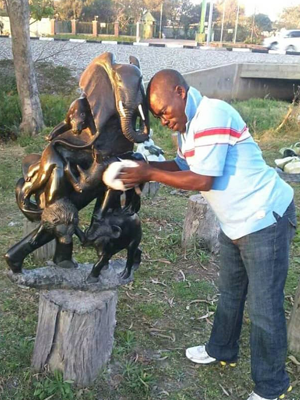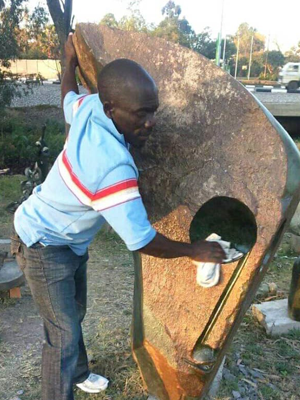If you are wondering which type of base for your sculpture, there are several choices depending on your style of living. The bases below are made of local stone. You can easily find out where your local ‘stone quarry’ is to you on Google and get blocks made to your exact measures, they can also pre-drill, deliver and even install it for a price!
Below are some ideas of bases;
At our exhibitions we mount our sculptures on wooden tree trunks as these are the least expensive and quick to install. These are great if your sculpture is not heavy, as obviously, even if the wood is treated, it will eventually rot and will need replacing. This is not a permanent solution.
Otherwise, if your sculpture is small and for indoors, you can ask your local carpenter or stone quarry to make something for you. An indoor base can be made of wood, plywood, fibre or stone. We found natural products compliment the stone more, see the following examples;
Ash wood base
Ash wood base on top of a black laminate block.
Is Your Sculpture Safe Outdoors in Cold Weather?
One of the most asked questions at our exhibitions! A stone sculpture will only have a problem if it is bought with a problem in it already. If the sculpture has a flaw or a crack in the surface, water can penetrate into that area and in freezing conditions can damage the sculpture, either by expanding the stone or in the worse case scenario splitting it altogether. The sculptor usually IS aware of the stone having a flaw in it from initiation as the stone doesn’t resonate the normal crisp tone as if it were perfect. It would make a dull sound on impact. Most reputable sculptors abandon the stones at an early stage if they feel it is flawed.
All of our sculptures are checked rigourously before even leaving Zimbabwe – once when they are initially bought from the sculptor and again when they are brought back to our Studio. They are then checked by our expert team of artists who work with us when packing our work to go to exhibitions. We have never knowingly sent a sculpture to an exhibition with a flaw in it, not only would this be misrepresenting to the customer that all of our sculptures are okay in cold climates, but it would be an expensive exercise for us too – it takes up valuable space in our shipment!
As we present our sculptures in an outdoor setting we are confident that these can stay in an outdoor environment forever, unless otherwise stated. The stone has lived for millions of years in a mountain, there’s no reason, despite it being sculpted with, that it cannot live another million years!
Here are some pictures clients have very kindly shared with us of their sculpture/s in ALL seasons… and in this link.


